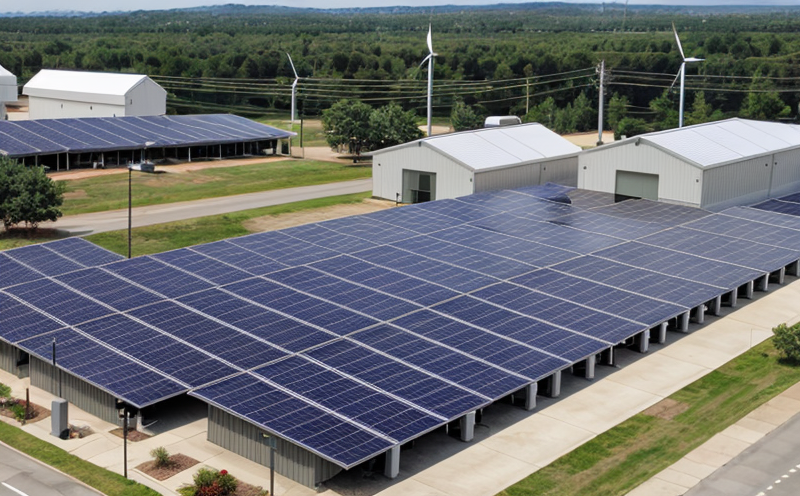IEC 62271 Switchgear Safety Testing for Microgrids
IEC 62271 is a series of international standards addressing the safety, performance, and environmental considerations related to switchgear used in power systems. In the context of microgrids and distributed energy systems (DES), these standards are crucial for ensuring reliable, safe, and efficient operation.
The testing under IEC 62271 is a comprehensive process that evaluates various aspects of switchgear, including insulation integrity, mechanical strength, thermal stability, and electrical performance. This service targets quality managers, compliance officers, R&D engineers, and procurement teams within the energy sector who are responsible for ensuring that their microgrid systems comply with international safety standards.
Switchgear in microgrids must be robust enough to handle both grid-connected and islanded operations seamlessly. The testing ensures that devices meet specific criteria under various conditions, including fault current, short-circuit withstand, and operational stability. This is particularly critical for DES where the system can operate independently of the main grid.
The process involves several stages: initial inspection, electrical testing, mechanical testing, thermal analysis, and final evaluation. Each stage is crucial in identifying potential issues that could lead to safety hazards or performance degradation. The testing ensures compliance with IEC 62271-501, which covers the electrical tests for switchgear.
The importance of this service cannot be overstated, especially as microgrids play an increasingly important role in the energy landscape. They provide reliability and resilience by reducing dependency on centralized power sources. By adhering to these standards, organizations can ensure that their systems are not only safe but also reliable and efficient.
One of the key aspects of this testing is its focus on safety. The IEC 62271 series of standards provides a framework for ensuring that switchgear operates safely under all conditions. This includes protection against overcurrents, overvoltages, and other potential hazards. The tests are designed to replicate real-world scenarios, providing accurate insights into the performance of the switchgear.
The testing also encompasses environmental considerations. With increasing focus on sustainability, DES must be environmentally friendly from both a production and operational standpoint. IEC 62271 supports this by ensuring that switchgear is energy-efficient and has minimal environmental impact during its lifecycle.
Microgrids are becoming more prevalent in various sectors such as utilities, commercial buildings, and remote communities. The testing under IEC 62271 helps ensure that these systems meet the highest safety standards, thereby enhancing reliability and reducing risks. By adhering to international standards like IEC 62271, organizations can demonstrate their commitment to quality and compliance.
Given the complexity of microgrids and DES, it is essential to have a comprehensive testing process that covers all aspects of switchgear performance. This ensures not only safety but also operational reliability. By following these standards, organizations can build trust with stakeholders while ensuring regulatory compliance.
| Test Parameters | Description |
|---|---|
| Insulation Integrity | Testing for dielectric strength and insulation resistance. |
| Short-Circuit Withstand | Evaluation of the switchgear's ability to safely interrupt fault currents. |
| Thermal Stability | Assessment of the switchgear's thermal performance under various conditions. |
| Electrical Performance | Testing for current-carrying capacity and voltage rating. |
Industry Applications
The IEC 62271 switchgear safety testing is particularly relevant in several key sectors:
- Utilities: Ensuring the reliability and safety of microgrids that supply power to critical infrastructure.
- Commercial Buildings: Providing resilient power solutions for data centers, hospitals, and other essential facilities.
- Rural Electrification: Supporting the installation of microgrids in remote areas where grid connectivity is limited or non-existent.
- Residential Communities: Enhancing the reliability and efficiency of distributed energy systems serving residential neighborhoods.
The testing ensures that switchgear used in these applications meets stringent safety standards, thereby enhancing system performance and reducing risks. By adhering to IEC 62271, organizations can ensure their microgrids are robust enough to handle both grid-connected and islanded operations safely.
| Application | Benefits |
|---|---|
| Rural Electrification | Improved reliability, reduced downtime, enhanced safety. |
| Commercial Buildings | Enhanced resilience against power disruptions, improved system efficiency. |
| Data Centers | Increased uptime, minimized risk of service interruptions. |
| Hospitals | Ensured continuous supply of critical power needs. |
International Acceptance and Recognition
The IEC 62271 series of standards is widely recognized and accepted in the international community. It is part of a broader framework that ensures consistency and reliability in switchgear performance across different regions.
- Australia: The Australian Standards align closely with IEC 62271, ensuring seamless integration with global practices.
- New Zealand: Similar to Australia, New Zealand standards are harmonized with international norms.
- Europe: Many European countries have adopted the IEC 62271 series as a national standard, reflecting its importance in the region.
- United States and Canada: While not officially part of the IEC standards, similar practices are followed to ensure compliance with international norms.
The widespread acceptance of these standards reflects their importance in ensuring safety and reliability across different jurisdictions. By adhering to IEC 62271, organizations can ensure that their switchgear is not only compliant but also meets the highest global standards.
Environmental and Sustainability Contributions
The testing under IEC 62271 plays a crucial role in promoting environmental sustainability within microgrid systems. By ensuring that switchgear operates efficiently and safely, this service helps reduce energy waste and environmental impact.
Efficient switchgear contributes to the overall efficiency of a microgrid system. This is particularly important in distributed energy systems where every kilowatt counts. By minimizing losses and maximizing performance, organizations can achieve significant cost savings while reducing their carbon footprint.
The testing ensures that switchgear meets stringent environmental criteria during its lifecycle, from manufacturing to disposal. This includes using environmentally friendly materials and processes, which are critical for the sustainability of microgrids. By adhering to these standards, organizations can demonstrate their commitment to sustainable practices.





